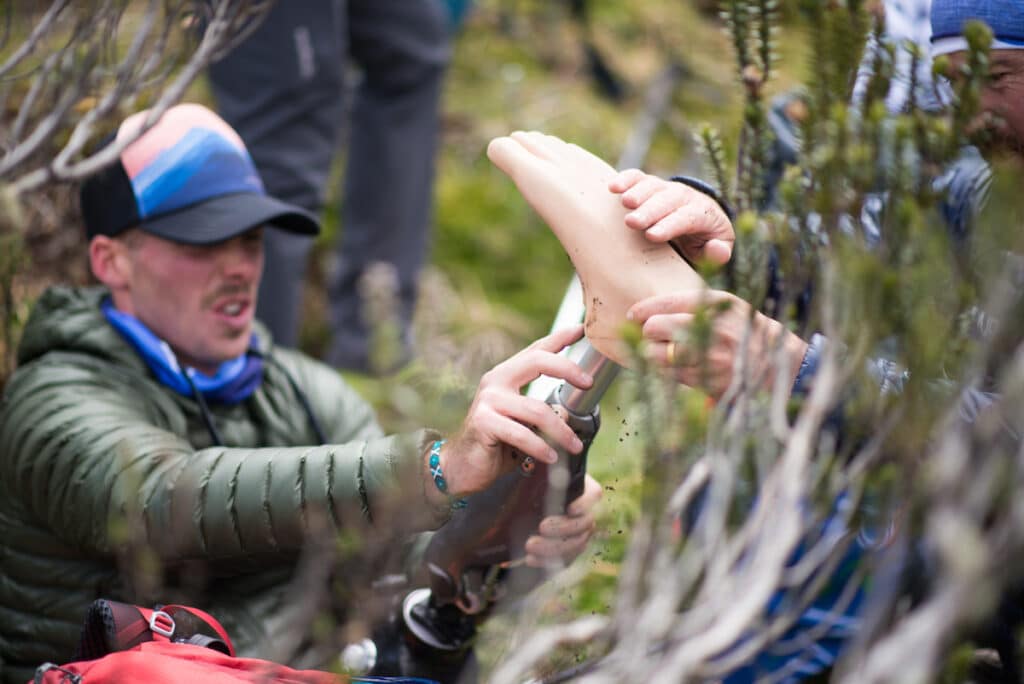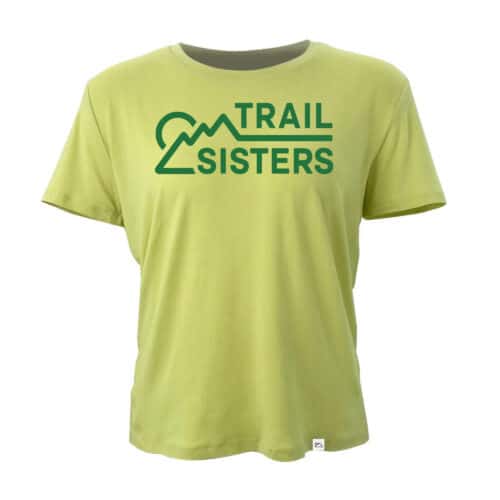Heidi Strickler is a 2022 Trail Sisters and The North Face Adventure Grant recipient. This is her adventure story!
I dropped my pack into the snow and pulled the wrist of my Mountain Hardware glove up just enough to look at my watch, to not expose too much skin to the sub-zero temperatures. My head pounded, my lungs burned, the lack of sleep and endless darkness playing mind games with me. I begged for it to be approaching sunrise. Four o’clock. Damnit. “Just one more hour until dawn, then another 60 minutes to the summit,” I told myself. Kyle Stepp, my rope partner, asked for the time as well, and I relayed my predicted time to summit to him. Not a minute later, our guide walked back towards us, “How are you feeling? Maybe just three or four hours more to the summit.”
At 11:50pm on October 6th, 2022 Kyle, José and I left Refugio Cotopaxi to begin our summit attempt at the Cotopaxi Volcano at 19,347 feet. We were among a team of 20 individuals, ten of whom were amputees – including Kyle – who were attempting to summit Cotopaxi that morning. We were brought together by, and were climbing for, Range of Motion Project (ROMP), a global non-profit organization dedicated to providing high-quality prosthetic care to amputees without access in the US and Latin America. This was the 8th annual Climb for ROMP, raising awareness around the disparity in prosthetic access for people with limb loss and raising money to provide more equitable health and prosthetic care for those in need.

According to the World Health organization, 9 in 10 people in need of a prosthetic worldwide are unable to access one. The Climbing for ROMP campaign is the non-profit’s largest mobility campaign of the year with a goal of raising over $150,000 to fund high quality prosthetic care and services to 100 ROMP patients. The campaign’s slogan “What’s Your Mountain?” reiterates the fact that climbing a mountain is sometimes easier than accessing high-quality healthcare. ROMP’s mission is “Empowerment Through Mobility:” We were climbing for ROMP, for mobility, for dreams; for each other’s visible and invisible mountains, and for our own.

And climb we did: between 6:30 and 8:00 am on Friday, October 7th, 2022 all 20 athletes from the ROMP 2022 Climb Team with their guides and 4 support climbers reached the Cotopaxi summit. It was the first time in history that the full team has made the summit, and the first time many of the team members had ever climbed a glacier at all. It has been over 2 months since that morning, and I have yet to find words that capture the experience, of the summit itself, and of the trip as a whole. Life changing nor inspiring really seem to capture the layers, the relationships, the stories, the mountains, or the entirety and depth of the experience.

I identify as an athlete and feel more at home in the mountains than anywhere else. I was raised exploring and climbing the mountains of Utah. Over the past 12 years I have become an avid trail and ultra-runner, and more recently discovered climbing, back country skiing, and mountaineering. Needless to say, I consider myself to have a higher-than-average aerobic capacity, a strong body, and a high level of comfort in adverse mountain terrain. Yet this trip was humbling in a way that I did not expect. But that’s what mountains do to you. That’s what adversity does to you. That’s what perspective does to you.

How do you define “able-bodied?” Webster, and society, define it as “fit, strong, and healthy; not physically disabled.” As if those two phrases are synonymous. But what causes physical disability? My involvement with the amputee community has shown me that is not a missing limb or amputation or broken body, rather, physical disability is caused by a missing prosthetic and a broken system. I have been involved with ROMP since 2019. I got involved because I met Nicole Ver Kuilen, an amputee and athlete who lost her leg to cancer when she was 10 years old. Nicole made me aware of just how hard those with limb loss have to fight for proper prosthetics. I learned that many prosthetics are not covered by insurance because they are deemed “unnecessary.” This means that someone with limb loss has to pay upwards of $10k for a limb that simply allows them to be active – to run, bike, hike, lift weights, ski, snowboard, rock climb. And that limb has to be replaced every few years. All I have to do is lace up my shoes, or throw on my skis, harness, and/or helmet. My mobility and ability have afforded me opportunities, relationships, experiences, lessons, self-growth, access; all of which I took for granted for most of my life. Suicide has a direct positive correlation with limb loss, and a direct negative correlation with physical activity and outdoor access. The prosthetic health care system is a broken system and I am passionate about changing it.

The term “able-bodied” is often used as the antonym to “amputee,” i.e. “a group of amputee and able-bodied athletes.” After less than 24 hours spent learning from my teammates in Quito, Ecuador, I realized the err in this verbiage. My amputee teammates were able-bodied. In some cases, it was their amputation that took away their physical disability, that made them able-bodied; that, and access to a proper prosthesis and prosthetic care. In the week leading up to our summit attempt, we stayed at Hacienda Los Mortiños, a lodge on the edge of Cotopaxi National Park. We alternated acclimatization training hikes and glacier training with rest days. Our first training hike was to the central summit of Rumiñahui Volcano at 15,489 feet. We climbed 3,000 feet in 4 miles, the last mile of which was scree and class 3 scrambling in questionable weather. I watched in awe as my amputee teammates maneuvered and muscled their prostheses over the terrain, sometimes with grace, sometimes with grit, most of the time with both. Very few of them had any mountain climbing experience. I hate “inspiration porn” as it has been termed, and I do not mean to turn this story or my experience into such. But just under the summit, watching my teammates grind and dig and push, I started crying. Tears for their triumph, tears for my ignorance, tears for those who can’t climb their own mountains because of a broken system built on ableism, racism, sexism, homophobia, to name a few. I cried because for the first time, I was tangibly experiencing why were all there. Why a group of 20 strangers had come together to raise a collective $150k and climb a giant glaciated volcano in the middle of the night in freezing temperatures with no sleep and high likelihood of altitude sickness. Every step we took that trip, from Ruminahui to the Cotpaxi Refuge and up to the Cotopaxi summit, was the highest step most of us had ever taken. The first step, the next, and the next. Hundreds of thousands of collective steps. Collective dollars. Collective reasons and stories. All represented by one summit.

Sunrise had come and gone, and with it false summit after false summit, curse word after curse word. At 7:40 am however, there it was. Quite possibly a feeling I will never be able to describe, but can only be captured in photos, and in the lump in my throat, fluttering of my heart, and smile on my face when I remember. There were three teams behind Kyle and I – teams we had not seen since sunrise, and I was unsure of they would make the summit. Due to the sun warming the glacier, you have to reach summit by a certain time in order to make it off the mountain safely, and every year teams had been turned around because they weren’t moving quickly enough. Then one by one, each team of three crested the final climb to the summit. It was only then that I learned that this had never happened: a full team had never made the summit before. To make this journey that much more epic: we had just made history.

By the time I returned to the Cotopaxi refuge I had been on the mountain for 12 hours. Some teammates were out there for longer. After food, more tears, showers, naps, and some time for each of us to become more like functioning humans again, we all shared stories, reflections, shout outs, gratitude, and challenges. One week prior, we were strangers, only having met over zoom calls in the months leading up to the trip. Now, we were a family, brought together by a mission and a passion bigger than us. In two days’ time we would all go our separate ways, back to our normal lives, but we would all be changed by way of fighting for and believing in change in a broken system. We all have our own mountains, visible and invisible; we all have our own summits; and we all deserve the chance to reach them. This is why we climb for ROMP.

Huge thank you to the Trail Sisters and North Face Adventure Grant! The $500 went directly to providing first steps and first hopes to lives in Ecuador. To date, ROMP has conducted over 12,500 patient visits, delivered more than 4,300 devices and raised more than $11 million in fundraising and value of in-kind donations since 2005. For more information about ROMP, its programs, and how to get more involved, please visit www.rompglobal.org or follow mobility stories on instagram @rompglobal.















